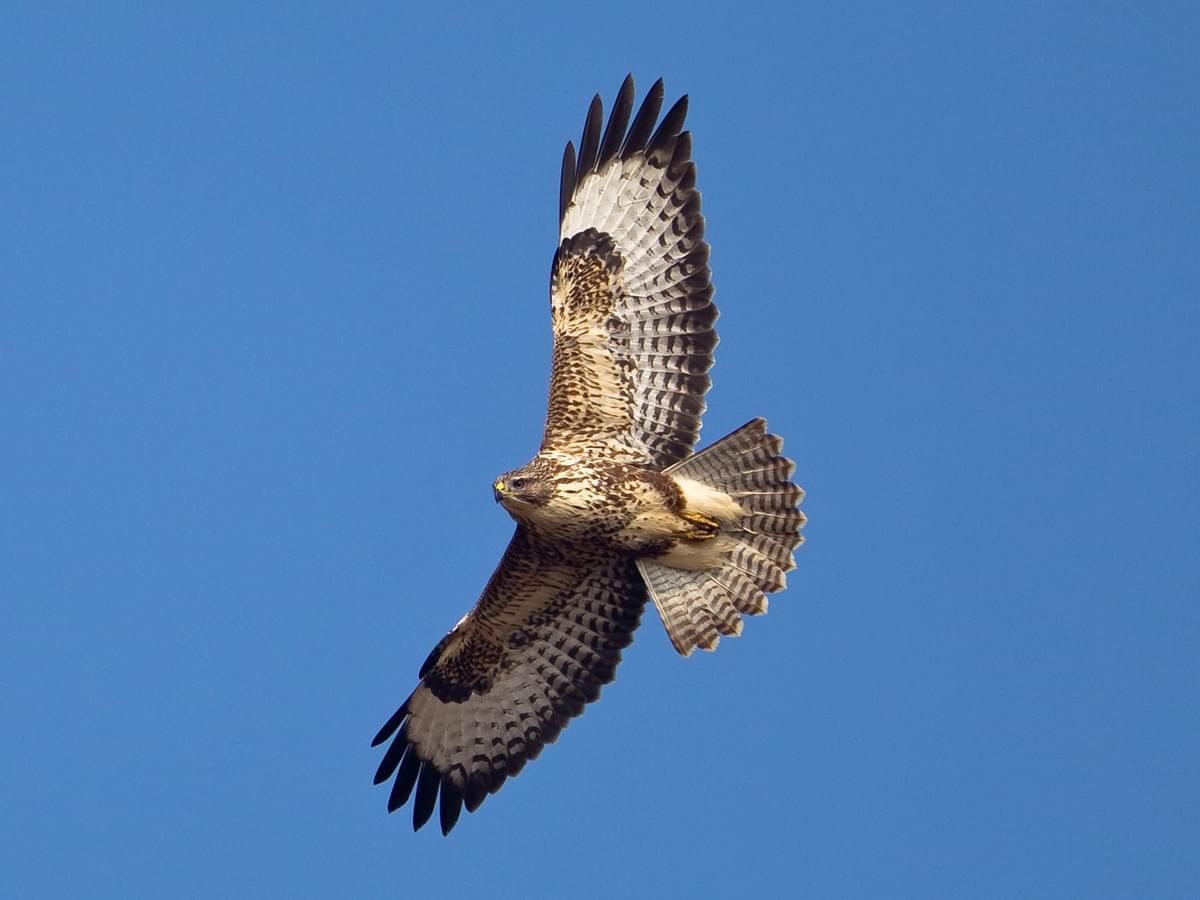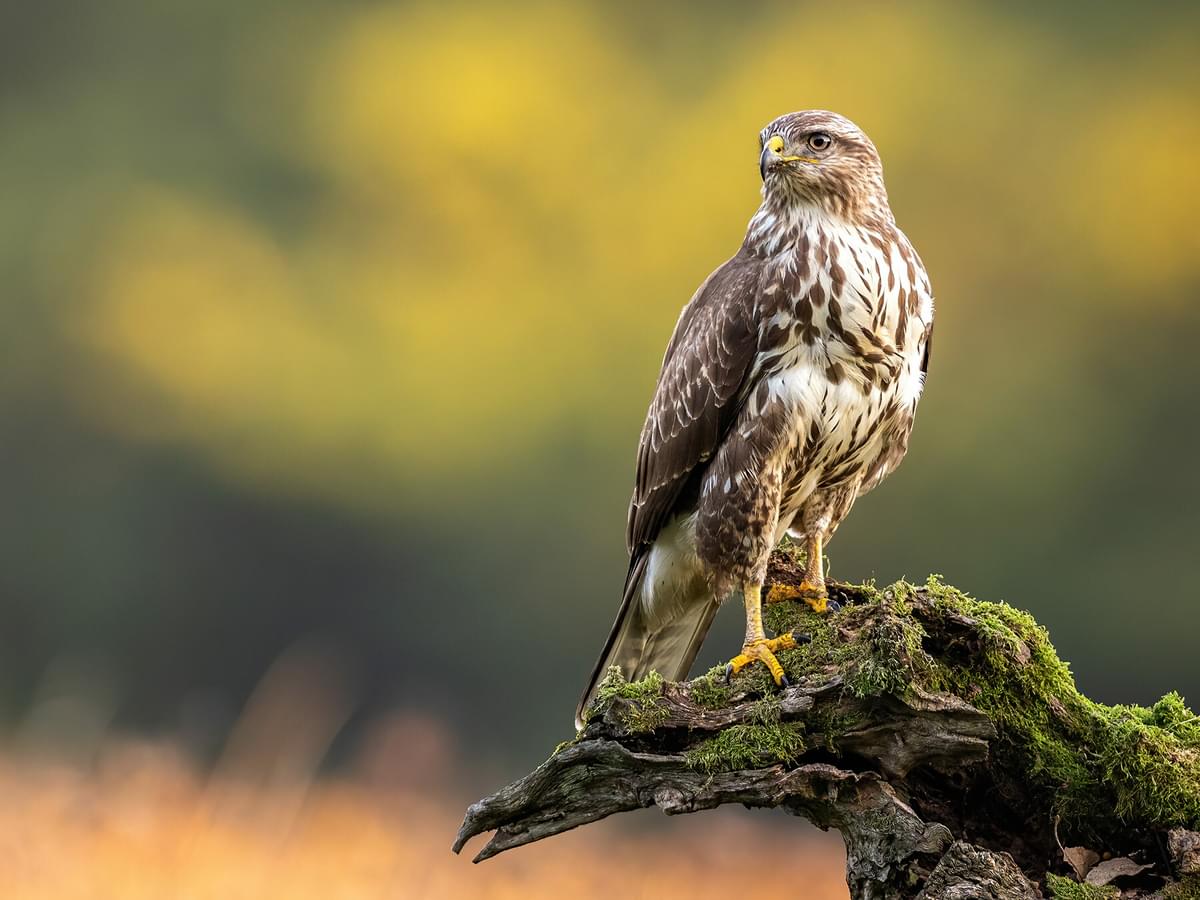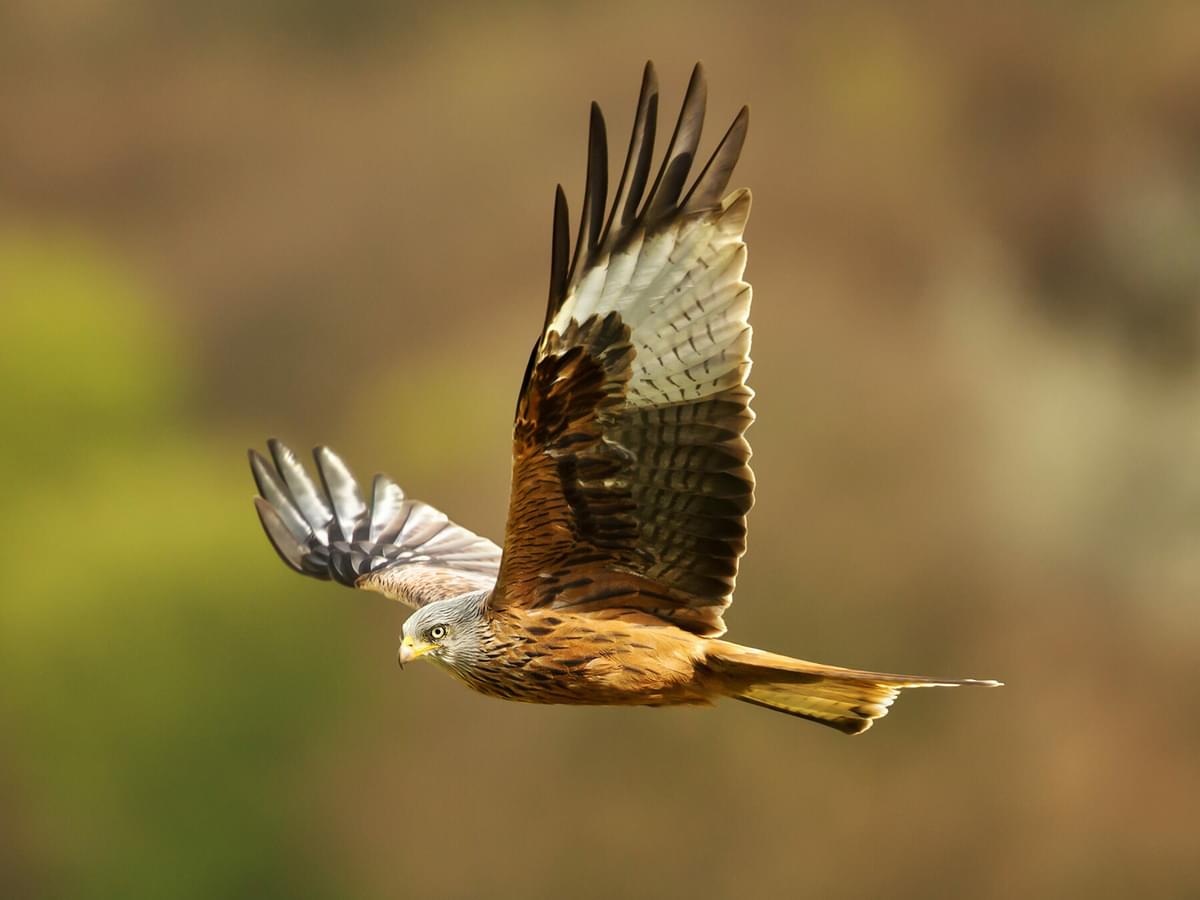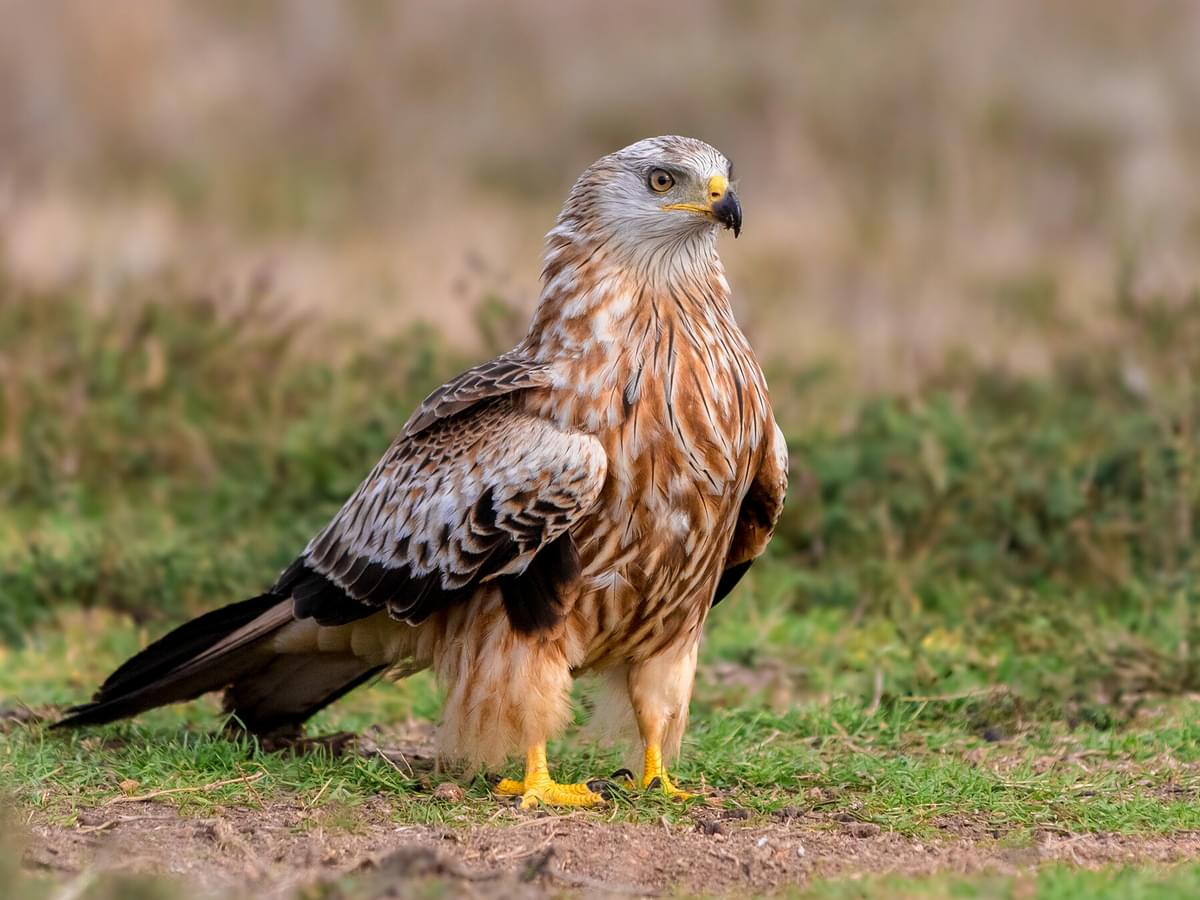That large bird of prey soaring lazily above the motorway? In Britain, it's likely either a buzzard or a red kite. While both are increasingly common sights across UK skies, telling them apart is straightforward once you know the key differences.
Quick Identification Guide
Common Buzzard:
- Medium-sized with broad, rounded wings held in a shallow 'V' when soaring
- Relatively short, fan-shaped tail that spreads wide when soaring
- Plumage varies from dark chocolate-brown to pale cream, usually with a pale 'panel' on underwings
- Makes a distinctive cat-like "pee-yow" mewing call
- Most common and widespread UK raptor
Red Kite:
- Rusty-red plumage with distinctive white patches under wings
- Long, deeply forked tail that constantly twists during flight
- More slender appearance with longer, narrower wings than a buzzard
- Less direct flight path, often gliding low with frequent changes in direction
- Widespread but more localised distribution than buzzards

Common Buzzard

Red Kite
Comparing Buzzards and Red Kites in Flight
The shape in flight offers the most reliable way to distinguish these birds. Buzzards display a compact silhouette with broad wings and a short, fanned tail. They typically soar in wide, steady circles, wings held in a shallow 'V'. Their flight pattern is generally direct and purposeful.
Red kites cut a more elegant figure overhead. Their deeply forked tail—constantly twisting as they adjust course—is instantly recognisable. Their flight appears more buoyant and playful, with birds frequently changing direction with minimal wing movement. Red kites typically fly lower than buzzards when hunting, often gliding just above treetop height while scanning for food.
While buzzards tend toward solitary hunting, red kites are more social. During winter especially, spotting multiple red kites together is common near known feeding or roosting sites, while buzzards generally maintain their territories even outside the breeding season.

Common Buzzard in flight

Red Kite in flight
Plumage Variations
Buzzard plumage shows remarkable variation. Some individuals appear almost uniformly dark brown, while others display extensive cream or white underparts.
Most show a distinctive pale chest band and pale "panels" on the underwing, visible when the bird soars overhead. This variability sometimes leads to misidentification, with particularly pale buzzards occasionally reported as other species.
Red kites remain more consistent in appearance. Their rich, rusty-red plumage contrasts beautifully with a pale grey head.
From below, prominent white patches on the underwings and the reddish fork-tipped tail create an unmistakable pattern. The contrast becomes especially striking in morning or evening light when the sun illuminates their russet feathers.
Buzzard
Buteo buteo

Length
51-57cm
Wingspan
113-128cm
Weight
550-1200g
Regional Rarity Score
Ranges from 0 (common) to 100 (extremely rare) in this region
Where to See Each Species
Buzzards have successfully colonised virtually every part of Britain. Once restricted to western and northern regions, they're now abundant nationwide, adapting to diverse habitats from remote moorlands to suburban parks. Look for them perched on roadside posts or telephone poles or soaring in circles over open country and woodland edges.
Red kites show a more localised distribution despite their successful reintroduction. Greatest concentrations occur around original release sites, particularly:
- The Chilterns (Buckinghamshire/Oxfordshire)
- Mid-Wales (Powys and Ceredigion)
- Yorkshire
- The Black Isle (Scotland)
- Northern Kesteven (Lincolnshire)
- Rutland & Leicestershire
- Cambridgeshire
They're gradually expanding outward from these core areas, with sightings increasingly reported across the Midlands and southern England. Unlike buzzards, red kites often venture into urban areas, especially around known feeding stations.
Red Kite
Milvus milvus

Length
60-66cm
Wingspan
145-165cm
Weight
800-1300g
Regional Rarity Score
Ranges from 0 (common) to 100 (extremely rare) in this region
Distinctive Behaviours
Recognising behaviour patterns offers another way to distinguish these birds. Buzzards are versatile hunters, employing three main strategies. They frequently soar high on thermals scanning for prey, hover kestrel-like over promising spots, or perch-hunt from prominent vantage points. When a buzzard spots potential prey, it drops with wings partially closed in a controlled stoop.
Watch for buzzards being mobbed by crows or smaller birds—a common sight that creates noisy aerial confrontations. Despite their predatory nature, buzzards rarely succeed in more than about 20% of hunting attempts, often appearing rather lethargic compared to other raptors.
Red kites primarily scavenge rather than hunt. They excel at finding carrion, sometimes gathering in groups around food sources. Their distinctive flight—low passes with frequent changes in direction—allows them to spot carrion, earthworms, or small rodents. Unlike buzzards, red kites rarely hover and seldom make direct predatory stoops.
A curious kite behaviour is their habit of collecting colourful or unusual items for nest decoration. Garden thefts of clothing, toys, or even underwear from washing lines have been reported in areas with high kite populations!

Close up of a Buzzard
Seasonal Highlights
Spring brings buzzards into their most visible period. Watch for their spectacular territorial displays, featuring steep climbs followed by dramatic diving and swooping, accompanied by their piercing calls. Pairs often soar together in synchronised aerial dances during courtship.
Winter offers the best opportunities for red kite observation. As daylight shortens, they gather at traditional communal roosts, sometimes numbering dozens or even hundreds of birds.
These pre-roost gatherings, typically in woodland areas, provide magnificent wildlife spectacles at sites like Watlington Hill in Oxfordshire or Gigrin Farm in Powys.

Red Kite Close Up
Conservation Contrast
These two species represent contrasting conservation stories. Buzzards, once heavily persecuted, made a natural comeback following legal protection and declining gamekeeping pressure after World War II. Their population grew from around 12,000 pairs in the 1980s to 57,000-79,000 pairs today.
Red kites exemplify active conservation intervention. Reduced to fewer than 10 pairs hidden in Welsh valleys by the 1930s, they faced extinction in Britain. A reintroduction program launched in 1989 has proven remarkably successful. From those first released birds, the UK population has surged to over 6,000 breeding pairs—a genuine conservation triumph.
The red kite's recovery dispelled historical misconceptions about them preying on game birds and livestock—unfounded fears that drove their initial persecution. Today, both species enjoy full legal protection, though isolated illegal persecution persists in some areas.

Perched Common Buzzard
Common Confusion
Even experienced birdwatchers occasionally misidentify these birds, especially at challenging angles or distances.
Buzzards soaring high with the sun behind them may appear to have a forked tail due to splayed feathers. Similarly, a red kite with its tail closed might momentarily resemble a buzzard's silhouette.
Learning the distinctive calls helps with identification. Buzzards produce a plaintive, cat-like "pee-yow" mewing sound that carries surprisingly far. Red kites make a more tremulous, whistling "weee-oo" call, typically less frequently heard than the buzzard's vocalisation.

Red Kite on the ground
Enjoying Britain's Aerial Predators
Both buzzards and red kites represent wildlife watching opportunities accessible to almost everyone in Britain. No special equipment or remote locations are needed—just keep your eyes on the skies, particularly while travelling through the countryside.
When you spot a large bird of prey circling overhead, first check the tail—forked for kite, straight-edged for buzzard. Then note the overall flight style—direct and powerful for buzzards, buoyant and manoeuvrable for kites.
With a bit of practice, differentiating these magnificent birds becomes second nature, adding depth to countryside journeys and garden observations alike.
The presence of these birds enriches our landscape and offers accessible wildlife encounters that connect us to Britain's wild heritage. Their different hunting styles, habitats, and behaviours provide endless fascination for casual spotters and dedicated birdwatchers alike.
